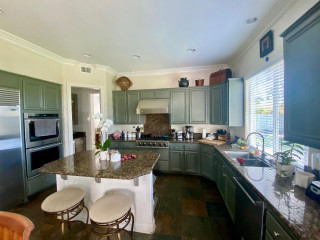
This article was originally published by a www.houzz.com . Read the Original article here. .

This article was originally published by a www.houzz.com . Read the Original article here. .
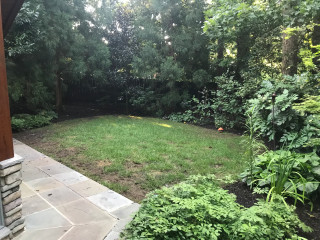
Patio at a Glance
Who lives here: Trevor Fulmer, who also designed the space, and his husband, Jim Mattus, a corporate attorney
Location: South Boston
Size: 585 square feet (54 square meters); 15 feet wide by 39 feet long
Builder: B H Brown Landscape Design
Before: This South Boston home’s original side yard was functional and sunny, but it felt boxed in by the perimeter fencing. There also was nothing to break up all the hard surfaces. Still, interior designer Trevor Fulmer and his husband immediately saw the potential. “Being in Boston proper with this square footage of outdoor livable space is very rare,” the designer says.
Fulmer quickly started dreaming up ideas for the space, including a lounge area with a fireplace. Plenty of plants also sat high on the list. “We wanted the space to feel very lush and green, like a little oasis in the concrete jungle,” he says.
This article was originally published by a www.houzz.com . Read the Original article here. .

Everything about the new shower makes life easier. It’s zero-threshold, with no curb to step over, and the barn-style glass door glides smoothly on a track. “It also has a large handle that’s easy for arthritic hands to pull,” Greenberg says. A towel bar on the door keeps things within easy reach.
The wife selected a botanical wallpaper that ties into the nature-inspired motifs of the Craftsman era. The tile design also stays true to the period. “My clients wanted traditional 3-by-5-inch subway tile, but we had to look quite hard for just the right cap. This one isn’t too clunky and has a profile that they liked,” Greenberg says.
The floor features matte white hexagonal tiles for maximum traction. “All the original bathroom floors in the house are white hex with black accents and we continued that pattern here,” Greenberg says. A slim black pencil tile around the room ties it all together. The many grout lines add slip resistance — another thoughtful aging-in-place feature.
Keeping the bathroom warm through Massachusetts winters was a key priority. The team refinished the original radiator, giving it a fresh look while retaining its powerful heat output. “That radiator pumps out a lot of heat and they love it,” Greenberg says.
The bath also includes a ceiling-light-fan-heater combo, a feature the homeowners appreciated in the original room. To make the space more energy-efficient, Greenberg’s team padded out the exterior wall for extra insulation and replaced the old window with a historically appropriate reproduction.
Wallpaper: April Blossom, York Wallcoverings
This article was originally published by a www.houzz.com . Read the Original article here. .
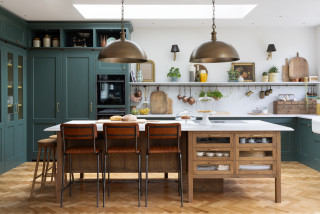
“The [owner] has a very good sense of style and knows what she wants, but we had to interpret that and work with the property and the space we were given,” he says.
The team crafted a beautiful modern-rustic kitchen with an elegant, elevated island and, hidden behind cabinet doors, a warm yellow pantry with masses of storage.
This article was originally published by a www.houzz.com . Read the Original article here. .
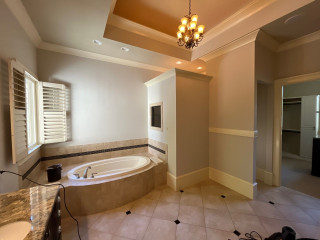
A Cary, North Carolina, couple who love to travel wanted their en suite primary bathroom to feel like a luxury hotel with spa-style amenities. Their existing space — with a dark traditional double vanity, separate tub and enclosed shower — was generously sized but lacked the wellness retreat atmosphere they envisioned. To help elevate the design and add modern comforts, they turned to design-build pros Steve Minor and Raul Bautista Perez of Noble Renovation.
The team reworked the old layout and created a modern wet room that combines a state-of-the-art steam shower and an inviting soaking tub, streamlining the footprint and providing a go-to spot for rest and rejuvenation. A larger custom white oak double vanity with a seated makeup station boosts storage while adding warmth and clean lines. A marble accent wall, backlit mirrors and soothing color palette enhance the calm, contemporary feel, giving the couple the next-level retreat they were after.
Before Photo
Bathroom at a Glance
Who lives here: A couple
Location: Cary, North Carolina
Size: 248 square feet (23 square meters)
Design-build team: Steve Minor and Raul Bautista Perez of Noble Renovation
Before: The former traditional-style bathroom, with its coffered ceiling and chandelier, felt heavy and disjointed. “There were high and uneven ceilings,” Minor says. “We wanted to create clean lines.”
One wall held a dark double vanity with a granite counter. Another had a drop-in tub with a bulky tiled deck that was difficult to use. To the right of the tub, an enclosed shower had a narrow entrance. A window over the tub covered with film attempted to bring light into the space. “That tub was really too tall for the wife to get in and out of and dominated the bathroom,” Minor says. “The wife wanted a tub that was easy to get in and out of and he wanted a steam shower, so that’s how the design developed.”
Across from the vanity, just out of view on the right, a water closet and a linen closet offered privacy and storage the homeowners wanted to keep but refresh.
The modern wet room features a custom black-tinted tempered glass enclosure with matte black hardware. The lower section is clad in matte wood-look fluted porcelain tiles, creating a soothing atmosphere. Inside the wet room, a black oversize shower panel is mounted on the ceiling. Just outside the entrance, a ceiling-mounted, humidity-sensing exhaust fan helps keep the bathroom comfortable and dry.
The back wall on the left is covered in ivory-toned marble panels with a textured, split-faced surface and interlocking design. A large backlit mirror illuminates the wall, highlighting the texture. “We were trying to add a statement when you walk in,” Minor says. “It also makes the room feel bigger. They love it. It adds a lot of drama.”
The flooring is 12-by-24-inch matte white onyx-look porcelain tiles with Wi-Fi-enabled radiant heat. The paneled door at the back opens to the updated primary closet, packed with storage solutions. “We continued the floor tile in there and it has a heated floor and LED lights,” Minor says. “It has a big window and an island in there as well.”
Accent wall: Splitface collection in Impero Reale, Anatolia
Find a home professional on Houzz
8 Golden Rules of Bathroom Design
The ceiling and sides of the bench and tub deck feature the same wood-look fluted tile used on the exterior of the wet room. The flooring and backs of the niches are tumbled mosaic marble stones. “In this bathroom, even the wet-room floor is heated,” Minor says. “The bench area is heated as well.” The walls are clad in the same porcelain tile used for the main bathroom flooring. “We made sure to waterproof every inch of that shower,” Minor adds.
The oval white 6-foot drop-in bathtub has built-in back support and armrests for comfort. A sleek 8-inch matte black tub spout coordinates with a matte black multifunction hand shower with push-button rinsing (not shown). “This tub was dropped 5 inches from the height of the previous tub so it’s very comfortable getting in and out,” Minor says.
Why you should hire a professional who uses Houzz Pro software
All drawers are fully functional — no false fronts here. The drawers beneath the sinks have U-shaped cutouts to accommodate plumbing, while two others include integrated power outlets for grooming tools. Twin white oval undermount sinks are paired with modern single-lever matte black faucets with graceful curved spouts.
A pair of custom backlit mirrors illuminates the wall and can shift between different colors. The lower-height makeup station offers two drawers, an open cubby and a round upholstered stool the couple already owned. A black iron-and-glass pendant light casts a warm, inviting glow over the space.
Mirrors: Grand Mirrors Eclipse, Evervue; faucets: Vivenis in matte black, Hansgrohe; vanity pulls: Princetonian in flat black, Top Knobs
5 Common Bathroom Design Mistakes to Avoid
Before Photo
Before: In the original bathroom, a dark double vanity with a granite countertop and traditional-style lighting dated the look and feel. A plain mirror that had previously hung above the vanity had already been removed when this photo was taken. The water closet is visible on the left, with the linen closet door partially seen behind the open door leading to the primary bedroom hallway.
New to home remodeling? Learn the basics
Towel warmer: Jeeves Model D in matte black, Amba Products
More on Houzz
Read more stories
Browse photos for ideas
Find a home professional
This article was originally published by a www.houzz.com . Read the Original article here. .

By eliminating two closets — one in the bathroom and one in the bedroom — and shifting the door to the primary suite, Pearson was able to expand the bathroom by 14 square feet and introduce a more efficient floor plan. The new design includes dual floating walnut vanities with storage towers, a spacious low-curb shower that spans the width of the room and improved lighting and ventilation throughout.
A restrained palette of white, black, gray and brown highlights rich materials, including Carrara marble mosaic tile and warm wood cabinetry. Geometric-patterned wall tiles add drama and dimension, while luxe brass accents bring a refined touch. The result is a sophisticated, light-filled bathroom with smart storage and enduring style.
This article was originally published by a www.houzz.com . Read the Original article here. .
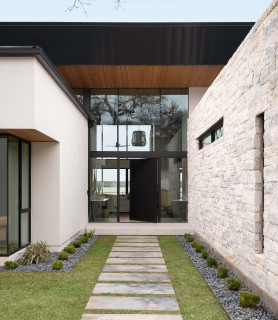
Etch began working with the original homeowners during the construction phase, helping select key finishes such as flooring, tile, countertops, cabinetry and lighting. The new homeowners purchased the house about two months before it was completed. After admiring Etch’s work online, they hired the team to help furnish the interior and layer in the final design elements — furniture, rugs, art and accessories — making some tweaks to tile and lighting along the way. The result is a warm contemporary home that’s family-friendly, with room for friends of all ages to have weekend fun at the lake.
This article was originally published by a www.houzz.com . Read the Original article here. .
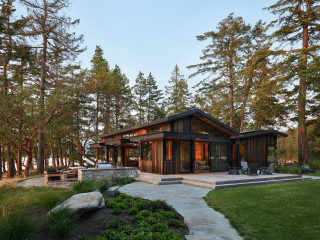
Creating the two asymmetrical forms broke up the scale of the house and gave it a San Juan Islands cabin feel. Butrim also looked to agricultural and maritime buildings, as well as Native American longhouses, for architectural inspiration. The materials, which include weathered cedar at random widths, tinted concrete and dark metal roofing, accomplish two goals. They nod to the history of cabins built on this island, and they help the building blend into the wooded site.
“Originally, the front entry led directly into the corridor,” Butrim says. “However, our clients thought that would feel too formal and they wanted this to be a more casual house. It also felt like an entrance you’d have if you’d driven from the road and down the driveway, which doesn’t happen here. Instead, we thought about them entering the house from the approach from the dock.” The front entry is located on the left side of the house. (The door is open in this photo.)
This article was originally published by a www.houzz.com . Read the Original article here. .

The small black-and-white en suite bathroom in this 1934 Colonial just outside Boston had vintage charm, but it fell short of the sophisticated retreat the new homeowners envisioned. The single pedestal sink offered no storage or counter space, and the aging shower-tub combo didn’t meet the couple’s needs. The nearby walk-in closet in the bedroom also lacked functional storage.
Looking to create a more spacious and practical layout, the couple hired design-build pros Jason and Megan Hoffman. Jason suggested pushing a wall shared by the bathroom and closet into the bedroom to gain valuable square footage. The reimagined bath now features a warm wood double vanity, a roomy low-curb shower with a built-in bench and a linen cabinet for added storage. A thoughtful mix of white, black and wood finishes with clean-lined midcentury touches brings modern style to this refreshed and highly functional space.
Before Photo
Bathroom at a Glance
Who lives here: A young couple
Location: Newton, Massachusetts
Size: 43 square feet (4 square meters)
Designers-builders: Jason and Megan Hoffman of J.P. Hoffman Design Build
Before: The 40-square-foot bathroom had charm thanks to its pedestal sink and classic black-and-white tile, but it lacked the storage and counter space the young couple needed in their primary suite. The aging shower-tub combo added to the challenges. “They have a tub in another bathroom, so that satisfied the home’s need for a tub,” Jason says. “Having no tub here opened up the opportunity to maximize the layout.”
Two existing windows — one beside the toilet and another at the end of the shower-tub — were in good shape, so the homeowners opted to keep them.
Find a bathroom designer
A pony wall on the left adds a touch of privacy for the new two-piece white toilet. A decorative walnut shelf above the toilet offers a warm accent. “We moved the new toilet 6 inches so everything on that wall now fits,” Jason says.
Creamy white paint (White Dove by Benjamin Moore) covers the walls, ceiling and trim, creating a clean, warm backdrop. Matte black details throughout add striking contrast.
10 Aging-in-Place Features Pros Swear By
Bronze and brass two-light fixtures with clear glass globes add a touch of midcentury style that complements the vanity. The bathroom also has recessed LED ceiling lights and a new exhaust fan, both of which were digitally removed from these photos to better highlight the room’s key design features.
Double vanity: Serenity door style in natural walnut, Candlelight Cabinetry; towel ring: Purist in matte black, Kohler; vanity pulls: Morris, Top Knobs; vanity lights: Young House Love Clear Glass Bubble, Shades of Light
Shop for bathroom vanities on Houzz
Creamy white glossy ceramic tiles, measuring 2 by 6½ inches, cover the wall above the vanity in a vertical stack pattern; the grout is frosty white. The tile’s subtle surface movement adds depth and texture. “We used that tile on the shower walls too,” Jason says. “By bringing the tile all the way across that wall, you’re creating less transitions and making the room seem bigger.”
Faucets: Jason Wu collection, matte black, Brizo; wall tiles: Wellfleet in Coconut, 2 by 6½ inches, Best Tile
10 Smart Bathroom Storage Solutions
On the bathroom floor, 4-by-12-inch matte black porcelain tiles are laid in a herringbone pattern and paired with midnight black grout, adding depth and visual interest.
Floor tile: Topography porcelain in black, 4 by 12 inches, Best Tile
See why you should hire a professional who uses Houzz Pro software
On the shower floor, hexagonal tumbled Carrara marble mosaic tiles bring natural variation in veining and tone, set with frosty white grout for soft contrast. “The homeowners liked the way everything looked when all the details were put together,” Jason says.
Shower floor tile: Antique Carrara hexagon tumbled, 2 by 2 inches, Best Tile
A hardwired black towel warmer with a programmable timer, mounted to the side of the linen cabinet, adds both function and luxury to the space. “We were able to redesign and update this bathroom without changing the location of windows,” Jason says. “The creativity and the ability to see the solution was key here.” For added privacy, the windows were fitted with a translucent film.
New to home remodeling? Learn the basics
Before: A swing door on the left once connected the bedroom and bathroom. An imposing dark armoire stood against the wall space between the door to the bathroom and the primary closet to its right. The door on the far right leads to the second-floor landing and staircase to the main level. The exposed metal ductwork visible at the back left is from a prior HVAC upgrade.
A new pocket door now connects the bedroom and bathroom. “It was related to the size of the bathroom and the location of switches to optimize space,” Jason says. The previously exposed ductwork is also gone. “We were able to enclose the necessary ductwork behind a wall in the new bathroom and added the valuable linen cabinet,” Megan says.
More on Houzz
Read more bathroom stories
Browse bathroom photos
Find a bathroom remodeler
Shop for your bathroom
This article was originally published by a www.houzz.com . Read the Original article here. .
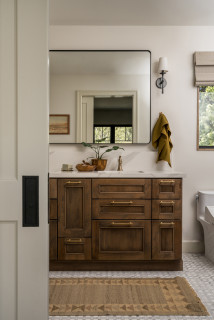
Bathroom at a Glance
Who lives here: A young family of three
Location: Long Beach, California
Size: 97 square feet (9 square meters)
Designer: Heather Knight-Willcock
Contractor: Bryan Luu of BLuu Construction
A large part of the project involved relocating the primary suite. Knight-Willcock found space for the primary bathroom by taking over a small existing hall bath, part of a hallway and space from two small closets. (See before-and-after floor plans below.) This allowed room for a double vanity, a generous shower stall and additional storage.
“Heather named this project ‘MCMR,’ which stands for Midcentury Modern Revival,” Luu says. Style-wise, this meant the design honors the home’s midcentury modern vintage while giving it modern conveniences and a warm organic feel.
This view from the bedroom shows a new paneled pocket door partially open on the left. “There is a small hallway to the left of this door. Using a pocket door optimized the space,” Luu says.
Find a local general contractor on Houzz
This article was originally published by a www.houzz.com . Read the Original article here. .
After: Now the kitchen has a streamlined look with dedicated storage and a refreshing cream-and-blue palette. Gone is the awkward butler’s pantry, replaced by glass-front cabinets for glassware and dishes. To the left of the new paneled fridge, an area that used to be a walk-in pantry now has cabinets for small appliances, bakeware, dry goods and a microwave.
To the right of the stove, a countertop cabinet hides a pullout shelf with a coffee bar and toaster, as well as stationary shelves for mugs and more. To the right of the sink, a cabinet with hammered glass doors keeps more dishware at hand.
Ramsay also removed a dining table and chairs (where the previous photo was taken from) and relocated a desk on the sink-side wall. This allowed for a more spacious island with seating for three, plus French doors that bathe the space in light. Wood-look luxury vinyl flooring grounds the space in beauty and practicality
Perimeter cabinet paint: Dumpling, Sherwin-Williams; island base paint: Hale Navy, Benjamin Moore
Read more about this project